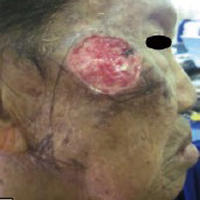Successful basal cell carcinoma defect reconstruction using combination of rotation and advancement flap: Two case reports
 Smart Citations
Smart CitationsSee how this article has been cited at scite.ai
scite shows how a scientific paper has been cited by providing the context of the citation, a classification describing whether it supports, mentions, or contrasts the cited claim, and a label indicating in which section the citation was made.
Defects resulting from surgical procedure may be challenging to reconstruct depending on the size and location. In case of large defects, primary closure is often not possible and thus requires skin flap or graft. In such cases, skin flap is advantageous as it produces a similar color and texture with the surrounding tissue. Skin flap techniques such as advancement flap, rotation flap dan transposition flap are useful in closing small defects. In moderate to large-sized defects, especially in areas with high tension, a combination of more than one type of flap might be necessary. This report describes two cases of large defects on the temple and cheek following basal cell carcinoma excisional surgery which were successfully closed using a combination of rotation and advancement flaps. Both patients showed excellent functional and cosmetic outcome.





 https://doi.org/10.4081/dr.2021.9087
https://doi.org/10.4081/dr.2021.9087





